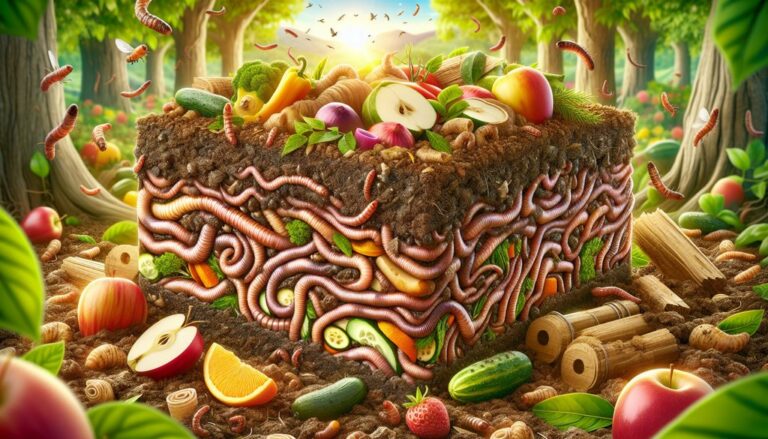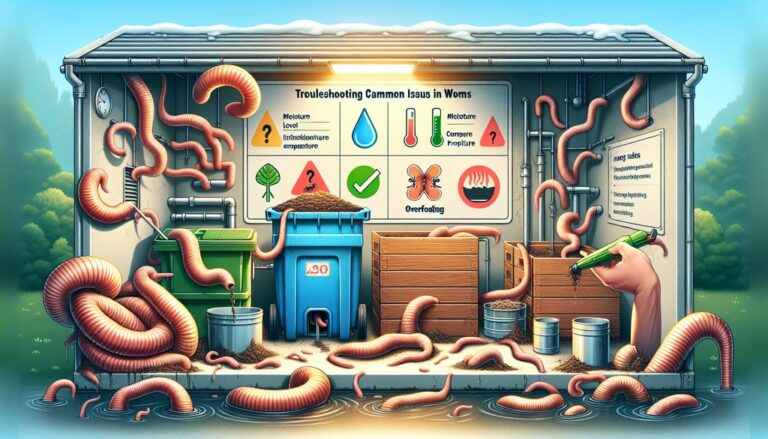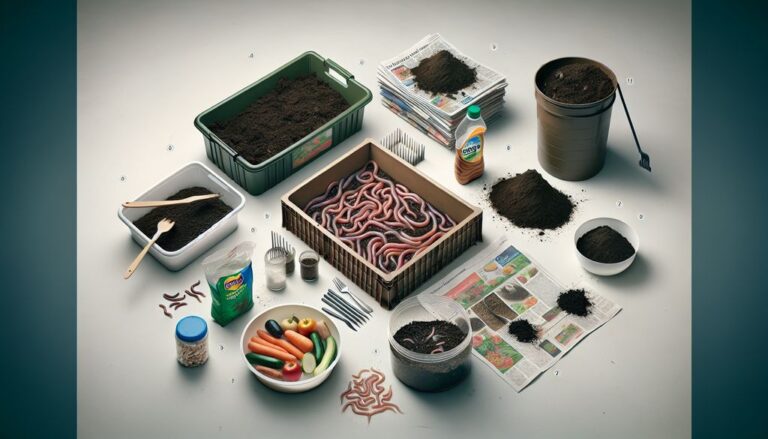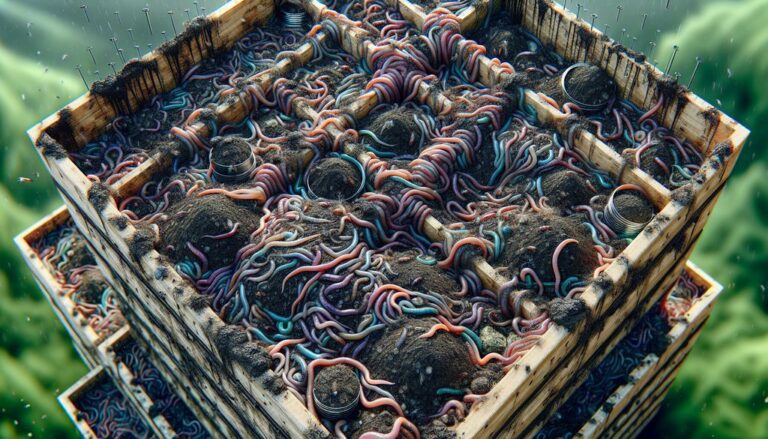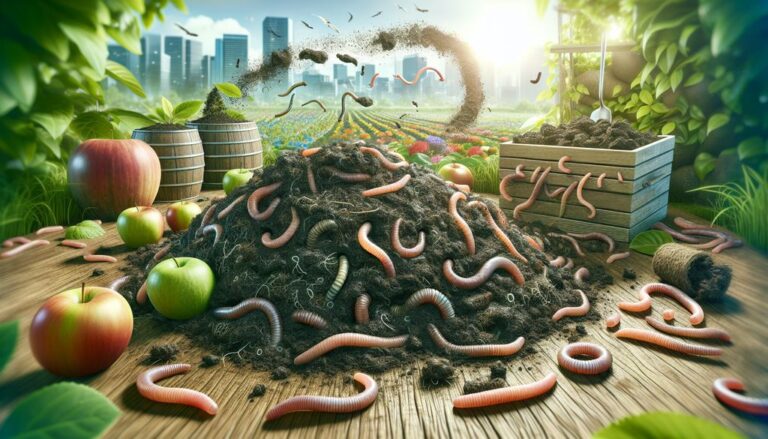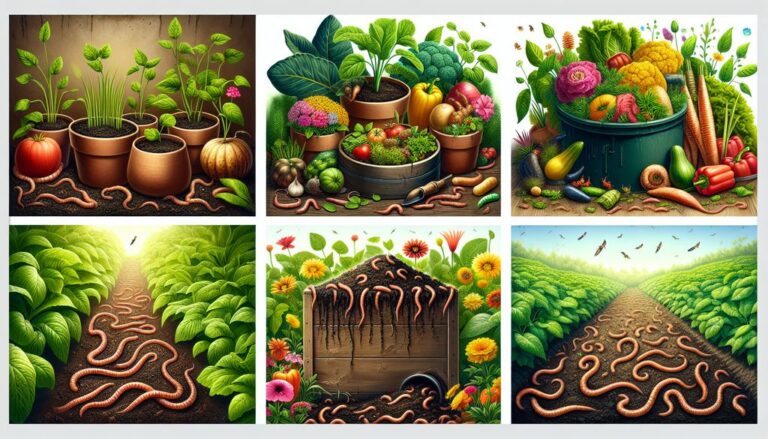Earthworms play a vital role in maintaining healthy soil and ecosystems. Understanding the different types of earthworms and their impact on gardens and ecosystems is essential for effective composting and sustainable gardening practices. In this article, we will explore the types of earthworms, their role in the garden, and their impact on ecosystems.
Key Takeaways
- Red wigglers (Eisenia fetida) are highly efficient composters and thrive on decaying organic matter.
- Night crawlers (Eisenia hortensis) are larger earthworms that live in the soil and contribute to soil aeration and drainage.
- European earthworms (Lumbricus terrestris) play a crucial role in transforming organic matter into new soil and improving soil nutrition.
- Earthworms are beneficial for soil health, aeration, drainage, and composting, making them valuable allies in sustainable gardening practices.
- The introduction of earthworms has had a significant impact on ecosystems, with East Coast woodlands experiencing changes due to the presence of earthworms.
Types of Earthworms
Red Wigglers
Red wigglers (Eisenia fetida), often referred to as the champions of composting, are a popular choice for vermicomposting bins. They thrive on decaying organic matter and are commonly found under stones, pots, and leaf piles. Unlike their larger cousins, the night crawlers, red wigglers are well-suited for the contained environment of a compost bin.
These worms are not only efficient at breaking down kitchen scraps and garden waste but also produce nutrient-rich castings. These castings, a form of mild fertilizer, can be directly applied to garden beds to enrich the soil. Gardeners may also add worm castings to planting holes to give seedlings a boost or sprinkle them on container plants as a slow-release fertilizer.
Red wigglers are voracious eaters and can consume up to 90 percent of the organic material provided to them, including items like newsprint, cardboard, and coffee grounds.
Here’s a quick list of what red wigglers can process:
- Newsprint
- Plain cardboard
- Eggshells
- Daffodil leaves
- Spent flowers
- Leftover vegetables
- Coffee grounds
- Animal fur
If you’re considering starting a compost bin, red wigglers are an excellent choice due to their adaptability and composting efficiency.
Night Crawlers
Night crawlers, or Lumbricus terrestris, are a familiar sight in gardens, especially after a rain when the air is damp. Unlike their smaller counterparts, the red wigglers, night crawlers are larger and tend to live in the first 12 inches of soil. They are known for their ability to aerate the soil and improve its structure through their tunneling activities.
Night crawlers are not as efficient in compost bins as red wigglers. For instance, an experiment with night crawlers in a compost bin resulted in no increase in their population over a year. This suggests that while they may contribute to the composting process, they are not the ideal choice for rapid composting.
Night crawlers feed on a variety of organic matter, but they prefer to surface and feed on plants when conditions are right.
Here’s a quick comparison between night crawlers and red wigglers:
- Size: Night crawlers are much larger than red wigglers.
- Habitat: Night crawlers live deeper in the soil, while red wigglers are often found under stones, pots, and leaf piles.
- Composting: Red wigglers are more efficient composters, thriving on decaying organic matter.
When considering worms for your compost bin, it’s important to choose species that are known for their composting abilities. While night crawlers play a vital role in the ecosystem, red wigglers are typically the better choice for composting purposes.
European Earthworms
European Earthworms, scientifically known as Lumbricus terrestris, are commonly found in the first 12 inches of soil across North America, Europe, and Asia. They play a crucial role in soil health, dining on microorganisms and producing castings that enrich the soil. Their burrowing activities not only aerate the soil but also enhance drainage and root formation.
European Earthworms are different from their compost-loving counterparts, the Red Wigglers, and the larger Night Crawlers that surface in damp conditions. Here are some of the benefits they provide:
- Transform organic matter into nutrient-rich soil
- Produce vermicast, a highly nutritious form of manure
- Create air passages in the soil to promote plant health
European Earthworms are essential for maintaining the fertility and structure of the soil, making them invaluable allies in the garden.
It’s important to note that while these earthworms are beneficial for garden soil, their introduction to new environments can have significant ecological impacts. For instance, on the East Coast of North America, they have altered woodland ecosystems by consuming the organic matter that native trees rely on. This highlights the need for careful consideration when introducing species to new habitats.
Role of Earthworms in the Garden
Soil Transformation
Earthworms are nature’s tillers, playing a crucial role in soil transformation. They convert organic matter into nutrient-rich soil, enhancing its fertility and structure. This process, known as vermicomposting, involves earthworms consuming decomposing organic material and excreting it as vermicast, which is a high-quality natural fertilizer.
- Vermicast improves soil structure
- Increases nutrient availability
- Enhances plant growth
By creating tunnels as they move, earthworms also promote soil aeration, which is vital for root development and water infiltration. A well-aerated soil allows for better root penetration and improved plant health.
Earthworm activity is essential for maintaining the balance of nutrients in the soil, making it more hospitable for plant life.
Gardeners can encourage earthworm presence by adding organic mulch, which attracts these beneficial creatures. A mulched garden not only provides a habitat for earthworms but also results in an abundance of vermicast, leading to a naturally fertile garden.
Aeration and Drainage
Earthworms play a crucial role in enhancing soil aeration and drainage, which are vital for healthy plant growth. As they burrow through the soil, earthworms create a network of tunnels. These tunnels allow air to circulate and water to percolate more effectively, preventing waterlogging and promoting strong root development. The presence of earthworms can significantly improve the soil structure, making it more porous and fertile.
- Soil Aeration: Earthworms push air through the soil, creating cavities essential for soil health.
- Improved Drainage: Their tunnels allow for better water movement, reducing the risk of waterlogging.
- Root Growth: The improved soil structure encourages robust root systems.
By maintaining a garden rich in organic matter, you can attract earthworms and benefit from their natural soil conditioning abilities. Regularly adding compost or mulch will keep them nourished and active in your garden.
Composting and Mulching
Composting is a natural process that transforms your kitchen scraps and yard waste into nutrient-rich soil amendment, perfect for gardening. Earthworms play a crucial role in this process, breaking down organic matter and enhancing the final compost with their castings. Mulching, on the other hand, involves covering the soil with a layer of organic material, which not only suppresses weeds but also provides a habitat for earthworms to thrive.
To start composting, simply layer your materials and maintain the pile’s moisture at the level of a wrung-out sponge. Regularly turn the pile to aerate it, which speeds up decomposition and can heat the center of the pile to between 100°F and 150°F. Over time, you’ll be rewarded with dark, peaty compost, teeming with beneficial microbes and earthworms.
Remember, small pieces compost faster, so chop up your waste into half- to two-inch pieces before adding it to the bin.
Here are some tips to optimize your composting and mulching efforts:
- Keep your composting tools sharp for efficient cutting of materials.
- Wear protective gear, such as gloves and a mask, when handling dry and dusty materials.
- Avoid adding soil to your compost pile as it makes it heavy and harder to turn.
- Use the larger, uncomposted pieces as mulch to start another composting cycle.
By following these practices, you’ll create a sustainable cycle that benefits both your garden and the local ecosystem.
Impact of Earthworms on Ecosystems
East Coast Woodlands
The introduction of earthworms to the East Coast woodlands has led to significant ecological changes. These invertebrates have transformed the forest floor, consuming the leaf litter and organic matter that native trees relied on for nutrients. This alteration in the nutrient cycle has prompted a shift in the woodland’s composition and structure.
Earthworm activity in these regions has been both a subject of fascination and concern, as the long-term effects on native plant species and forest dynamics continue to unfold.
While earthworms are often celebrated for their role in soil health, their impact on East Coast woodlands illustrates a complex relationship with the ecosystem:
- They accelerate the decomposition of organic matter.
- This can lead to a reduction in the layer of leaf litter.
- Native plant species that depend on this layer for germination and growth are affected.
- The altered soil composition may favor invasive plant species that can outcompete native flora.
Understanding the role of earthworms in different environments is crucial for gardeners and conservationists alike. It’s a reminder that the introduction of non-native species can have unintended consequences on local ecosystems.
Western U.S. Agriculture
In the Western United States, earthworms have played a significant role in enhancing soil quality and agricultural productivity. Unlike the East Coast, where the introduction of earthworms has led to ecological changes, in the West, these invertebrates have been largely beneficial. Earthworms contribute to the fertility of the soil, making it more hospitable for the growth of various crops.
- Earthworms improve soil structure by creating tunnels, which aids in aeration and water retention.
- They break down organic matter, releasing nutrients that are essential for plant growth.
- Their castings, or waste, are a high-quality natural fertilizer.
The presence of earthworms in agricultural land is often an indicator of healthy, productive soil. Their activity not only supports plant life but also enhances the overall sustainability of farming practices.
Farmers and gardeners in the Western U.S. recognize the value of these creatures and often introduce them to fields and gardens to promote better crop yields. While the full impact of earthworms on Western ecosystems continues to be studied, their positive influence on agriculture is undeniable.
Conclusion
In conclusion, when it comes to choosing the best worm species for your bin, it’s important to consider the specific needs of your composting environment. Each species, from red wigglers to night crawlers, offers unique benefits and characteristics that can contribute to the success of your composting efforts. Understanding the behavior and preferences of these worm species can help you create an optimal environment for composting and soil improvement. By selecting the right worm species for your bin, you can enhance the quality of your compost and promote a healthier garden ecosystem. So, whether it’s red wigglers or night crawlers, the key is to work in harmony with these valuable garden allies for a thriving and sustainable garden.
Frequently Asked Questions
What are the best earthworms for composting?
Red Wigglers (Eisenia fetida) are considered the best earthworms for composting due to their efficient consumption of decaying organic matter.
How do earthworms contribute to soil transformation?
Earthworms transform organic matter like compost or mulch into new soil, improving soil structure and fertility.
Do earthworms help with aeration and drainage?
Yes, earthworm activities produce tunnels that improve drainage and encourage root formation, while also aerating the soil.
What is the impact of earthworms on East Coast woodlands?
The introduction of earthworms has led to significant changes in East Coast woodlands, affecting the soil and nutrient cycling.
Can different species of earthworms coexist in the same environment?
Yes, different species of earthworms can coexist in the same environment as they may not be interested in the same decaying material.
How do earthworms benefit Western U.S. agriculture?
In the Western U.S., earthworms have benefited the soil and agriculture by improving soil structure and fertility.

